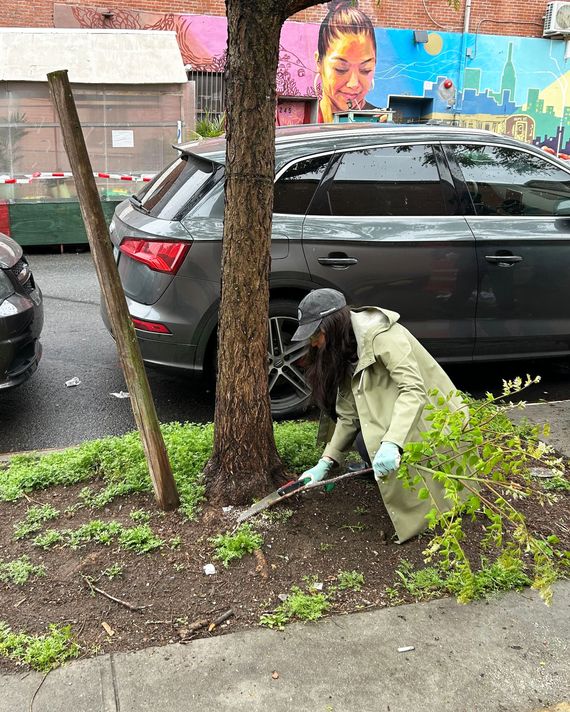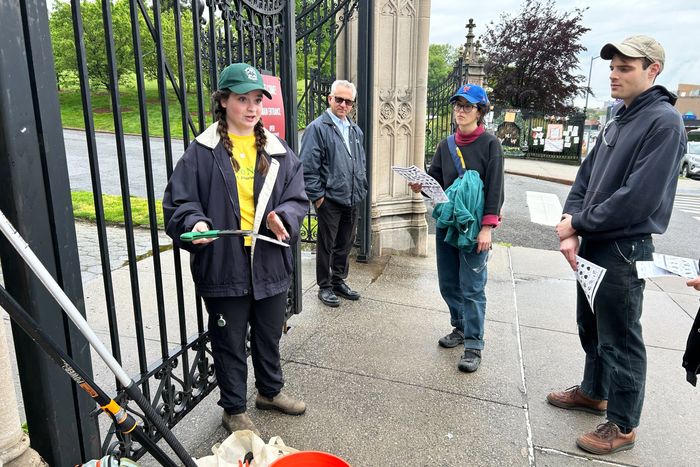How to Get a Tree-Pruning License in NYC


The citizen street-tree pruner must live by certain rules: Sharp, clean tools are a pruner’s best friend. No climbing — all of your tree maintenance must be done with two feet on the ground. (“Never stand on a ladder, nor a trash can.”) You are an ambassador of street trees, so keep the peace. If someone is mad at you for cutting down a wayward branch, even after you’ve explained that actually you are very specifically licensed to perform random acts of tree upkeep, “stop pruning and walk away.” Best to avoid the fight, as “this is a big city with many other trees that need you.”
On a rainy May morning, I am standing at the gates of Greenwood Cemetery with seven other pruners-in-training to learn this sacred code. It wasn’t easy to get here. “Last year I tried to sign up and I didn’t have my credit card with me so I had to run downstairs and get it — but when I came back upstairs, it was all gone,” Curlene Nelson, an IT worker from Queens, said of trying to get a spot in Trees New York’s citizen-pruner class. “This time I was ready.” A deluge of interest often means the website crashes when sign-ups go live. The last class filled up in 11 minutes. It was seven minutes the time before that. The most sought-after private club in New York City isn’t Zero Bond, it’s a four-session, $100 course on using a pole saw to take down a diseased section of a Kentucky coffeetree.
Photo: Clio Chang
While the Parks Department is largely responsible for regular street-tree maintenance, the city’s 650,000-plus street trees are always in need of extra support. Last year, Trees New York, a tree-stewardship nonprofit founded in 1976, trained 300 citizen pruners, each leaving the course with a citizen tree-pruning license that’s good for five years and the right to assess, and adjust, any public tree in their path. (Though this has its limits: They are not allowed to prune on private property and instead are advised to report a distressed tree to the property owner and 311. Park-tree adjustments, an entirely different turf, is also not allowed unless done in conjunction with the park’s administrator.)
Christina McLaughlin, who has been teaching this course for the last year, starts the class by going over the different tools she has with her, which include a pole saw, a pole pruner, and a bucket. She identifies trees for us as we walk down 23rd Street, with students eager to guess correctly. “One of these times I’m going to be right,” a student mutters to himself after misidentifying a Japanese Pagoda tree as a locust. When we get to a Chinese elm, McLaughlin points out a branch that is crossing over another that looks like a good target for pruning. The class gets into formation. (Another bit of the pruner’s code: It is good to prune with a partner.) One student holds the branch, while another saws it off. After it comes down, Andrea, an urban planner , wonders out loud how the ten-foot-long branch will fit in the bucket. The class works on breaking it down into perfect little segments and they all rest neatly in the bucket. “It’s like magic,” Andrea says.
Photo: Clio Chang
McLaughlin passes on some mantras for beginners — cut away from oneself (first-aid kits are best when they “produce dust”), only prune up to 20 percent of the tree, and Christmas lights are okay on a tree for the holidays but not all year round. Trees might need pruning for a number of reasons. Branches die or become too crowded, while others are simply in the way. The latter is why Paul Curiale, an especially eager student from Marine Park, got into the class. “I’m maybe not as into trees as others in the group but I’m really into safety,” Curiale said. At one point, everyone seems nervous that a small stub he’s cutting down might hit a car, but Curiale ends up catching it midair. Everyone cheers.
Perhaps unsurprisingly, Curiale is the outlier. Most of the people in class are very into trees. Nelson, who had tried and failed to get into the class last year, said she always wanted to be an agriculturist growing up, but ended up in IT. The class is her way of living out that version of her life while keeping her day job. I can hear her whisper “I’m so excited” as someone saws into a branch. The class has awakened something in everyone, it seems. “I missed the bus the other day staring at a tree,” Andrea tells me.
McLaughlin is also a tree obsessive, naturally. “The next tree I’m going to fangirl out a bit because I love this tree,” she says as we approach a bald cypress with red-streaked bark and elegant symmetrical branches arching upward. (The class ooohs and ahhs.) But we leave it without so much as a snip. “These trees thin themselves out so we don’t have to do too much work,” McLaughlin says. Perhaps as important as knowing when to prune is knowing when not to prune. Some trees are just perfect as they are.
Source link






